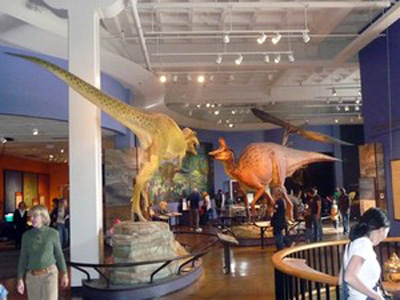By Donald H. Harrison

SAN DIEGO—A visit to the dinosaur exhibit at the Natural History Museum of San Diego can provide the so-called mighty human with a humbling perspective. Creatures in the air, on land and in the sea all might have regarded him as nothing more than a tasty lunch. Luckily for man, he didn’t arrive on the scene until well after the dinosaurs were already extinct.
Upon entering the Natural History Museum from its northern entrance near Balboa Park’s Moreton Bay fig tree, one gets a sense of just how physically insignificant man really is. Visitors almost immediately encounter an allosaur.
The allosaurs were “the biggest, most fearsome predators of their time in the late Jurassic period,” according to a printed narration besides a re-created skeleton of this creature. “Long jaws, dagger-like teeth, robust legs, cyclical-shaped claws and a massive tail all indicate that the allosuar was an active predator…”
So if humans lived 140 million years ago, it would have been prudent to avoid walking around in the allosaurs’ neighborhood. Not that a dip in the sea during prehistoric times would have been any safer for the fragile human. Xiphactinus, also known as the wolf herring, might have been lurking about. .
The giant meat-eating fish “lived 85 million years ago during the Cretaceous period,” another sign related. “At that time a vast shallow epicontinental sea covered much of the central United States. The powerful upturned jaws of Xiphactinus were equipped with large fang-like teeth at the front of the mouth. The jaws were very mobile and could be opened wide to take in large size prey as evidenced by the discovery of Xipactinus fossils with meter-long fish skeletons in their abdominal regions. The jaw and dental features of this fossil fish, together with its deep and forked tail, long body and large pectoral fins suggest that Xiphactinus was an extremely fast and powerful swimmer and an active and efficient predator.”
Nor could one hide in a tree, or on a cliff, and hope to leisurely survey all below. The Pterosaur, replicated at the museum with a large fish in his mouth, would not have had difficulty making a meal out of a human child.
The pterosaur is on the museum’s second floor which can be accessed directly from the Plaza de Balboa near the Bea Evenson Fountain. The creature is shown in conjunction with the sculpture of an Anklyosaur and is within hailing distance of an Albertosaurus and a Lambeosaur.
The Anklyosaur was an armored dinosaur, easy to recognize, but difficult for the larger predators to eat.
Albertosaurus, according to the museum’s narration, “shares many features with its big cousin Tyrannosaurus but Albertosaurus has a smaller body and bigger arms. Eyes face forward perhaps for depth perception… Curved teeth lock down on struggling prey. Thick and finely serrated, they pierce flesh and crush bones. Massive jaw and neck let albertosaurus attack with its head. Long, strong legs increase stride length and speed. Reduced foot bones and short claws improve running efficiency.”
Albertosaurus, in other words, is a killing machine. Gentler dinosaurs in its path may feel like lambeosaurs led to slaughter.
In the imaginative display, lambeosaur is depicted with its egg, which visitors may help “hatch” by turning a wheel to lift the top of the egg and expose a nearly-born inside. The two sided representation of lambeosaurus shows the giant reptile’s skeleton when viewed from one direction, its exterior when viewed from the other.
The museum poses the question that has divided paleontologists for many years. What exactly caused the extinction of the dinosaurs? The narrative favors the theory that a giant asteroid smashed into the earth, with the impact not only killing everything within its vicinity but putting into motion a chain reaction of volcanic eruptions that could have warmed and poisoned the atmosphere some 65 million years ago.
With the extinction of the dinosaurs—oh, see how the mighty have fallen—the museum posits that small mammals related to modern-day opossums came into their own, evolving into many varieties of modern-day mammals.
“Opossums’ basic body plan lets them live in many habitats and eat a variety of foods,” the museum notes. “Pointed teeth crunch insects, pierce and strip carcasses. A prehensile tail acts like a fifth leg for grasping branches. And a small body with four legs and five digits enable running, climbing, swimming and digging.”
The Natural History Museum helps visitors picture what San Diego might have looked like in the Eocene age, 20 million years after the dinosaurs met their end. San Diego was not the semi-arid landscape it is today. It more resembled a swamp.
“As the sun rises over the mangroves, nocturnal mammals settle down as the day shift begins… In the lagoon, fish find safe haven away from the pounding surf… Clams, oysters and snails live among the mud flats, tidal channels and mangrove roots. Boas lurk in the trees waiting for unwary prey. Crocodiles prowl for breakfast. On higher ground, tortoises awake under domed shells…”
In another room, the lesson is taught that although some animals today are just as threatened as the dinosaurs, mammoths and mastodons whose great weight pounded the earth, man is in a position to help.
For example, there is the California condor which dropped to a population of 25 or less during the 1980s. “The effort of the San Diego and Los Angeles Zoos to breed condors in captivity have been remarkably successful and releases of captive condors into the wilderness of northern Ventura County began in 1992.”
*
Harrison is editor of San Diego Jewish World. This article appeared previously on examiner.com
